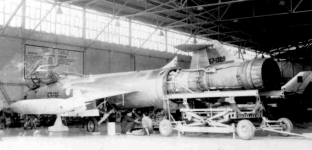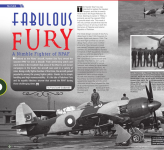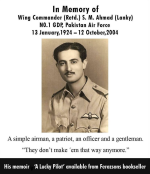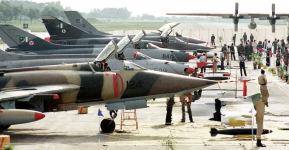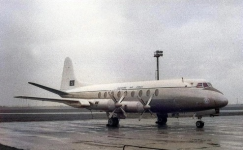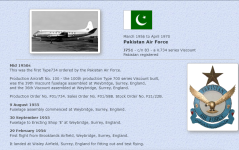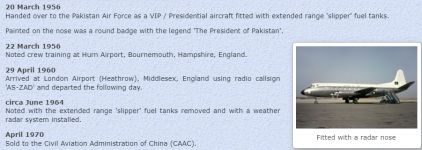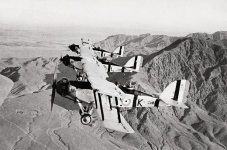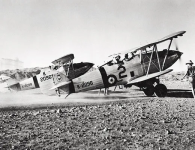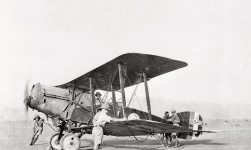By Wing Commander Saqib Shafi
At the time of its inception, the Pakistan Air Force (PAF) constituted a group of little more than 2,000 men of strong mettle flying a fleet of 16 TEMPEST II piston-engine fighter/bombers, two C-47 DAKOTA transports, twelve T-6G HARWARDs and seven TIGER MOTH biplanes.
This "force" had hardly a credible air defence element; whatever equipment reached Pakistan was not serviceable, and moreover maintenance facilities were virtually lacking. Although Pakistan, by dint of its geographical location, inherited seven operational air fields, some of these even lacked the barest minimum facilities of an operational base.
Thus, the start was modest in its literal sense but high ambitions blended with staunch resolution of those pioneering air warriors were unfettered, unlimited and un-abounded. Despite all these odds and infirmities, the PAF has developed into a invincible might over a period of 54 years.
The Beginning
From 1947 to 1965, the PAF was the Royal Pakistan Air Force and was commanded by four British C-in-Cs in a row. During this period the Flying Training School at Risalpur evolved into a model unit of the RPAF. The other two flying elements (the fighter force and the transport squadron) did not develop as well; however when put to test the operational tasks of valley supply drops by DAKOTAs and HELIFAXs as part of the Kashmir War, and the spasmodic "watch-and-ward" affrays by fighter aircraft over Waziristan, were executed successfully.
1957 was a momentous year for the Pakistan Air Force, with the induction of 100 F-86 SABREs jet fighters under the US aid programme. A wave of professional enthusiasm surged through the ranks of the PAF, as squadron after squadron of fighter pilots said farewell to their FURYs or ATTACKERs and joined the queue to fly the SABRE, "the SPITFIRE of jet fighters".
The new C-in-C of PAF, Asghar Khan established a Fighter Leader's School aimed at producing a class of air warriors. The arrival of the SABREs was followed by the procurement of B-57 light bombers and eventually F-104 STARFIGHTERS Mach 2 fighters. These inductions necessitated sweeping changes in many spheres of professional activity.
Engineering and logistics made a wholesale and somewhat painful switch over to American systems. As combat training programmes became more realistic and dynamic, they gave birth to a new breed of professional flyers who strove to excel in the "hard-core" skills of their trade rather than in showy dangerous manoeuvres.
War Experience
By the end of August 1965, the war between India and Pakistan loomed inevitable. On 1 September, the PAF was placed on a high state of alert, and combat air patrols (CAPs) were being flown by PAF aircraft 10 miles inside their border. The first encounter took place when a CAP of two F-86s intercepted four intruding IAF VAMPIREs. Sqn Ldr Rafiqui and his wingman, Flt Lt Bhatti shot down two VAMPIREs each. The IAF did not use its VAMPIREs again in that war.
On 6 September 1965, when the Indian Army invaded West Pakistan, the IAF did not strike PAF bases. The opportunity was, thus, exploited by the PAF which attacked IAF bases to reduce the threat posed by Indian aircraft. These strikes were not much of a success, except for Pathan Kot where PAF forces destroyed at least ten IAF aircraft on the ground without losses on their own.
On 7 September, it was the IAF's turn; as expected, the main thrust of IAF's strikes was Sargodha, the hub of PAF's operational activity. The early morning strike by six IAF MYSTEREs was a failure, as they missed six gleaming fighters parked on the ORP. One of these lucky pilots was Sqn Ldr Alam, who a few minutes after this raid took to the skies and established a combat record which has few equals in the history of jet warfare; Alam claimed shooting down up to five enemy aircraft within a few minutes, including three within 30-40 seconds.
7 September was the first and last attempt by the IAF to reduce the effectiveness of the Pakistan Air Force by daylight attacks against Sargodha. IAF pilots also showed a growing reluctance to engage in aerial combat, leaving the PAF in virtual control of the skies over the battle areas. The PAF was thus, able to render increased assistance to the land forces throughout the war.
In response to the US aid embargo of 1965, the PAF had to look for alternatives solution to continue on the re-equipment programme of its combat fleet. As a first step, the Chinese F-6 entered the PAF inventory in early 1966; the arrival of the MIRAGEs in mid-'67 represented a new but quantitatively limited addition to the service's counter-air and air defence capabilities.
Despite these new acquisitions, at the eve of the 1971 war the odds were set heavily against the PAF. The service, however, had retained its distinct qualitative edge, and despite the overnight loss of a third of its East Pakistani manpower, it fought the unevenly matched duel fiercely, and successfully contained an adversary four times its size.
Fleet Renewal
After the 1971 war, the PAF launched a programme to revitalise its structure and assets. New operational bases were built; the obsolete T-33 jet trainer was replaced by the Chinese FT-5; MIRAGE and F-6 re-build factories were established, along with a factory for production of the MFI-17 trainer. Moreover, the air defence network was modernised through the introduction of state-of-the art radars interfaced with computerised data processing and display equipment.
In 1980, A-5 ground attack aircraft were bought from China, and finally the F-16 FIGHTING FALCON entered the PAF inventory in 1982. The Soviet invasion of Afghanistan was yet another challenge for the PAF, which gave a good account of itself. Between May 1986 and November 1988, PAF aircraft shot down nine intruders within Pakistan's airspace, including three Su-22s, two MiG-23s, one An-12 and one Su-25.
The PAF had originally planned its force structure to include more than a hundred F-16s by the end of the century, but these plans could not be implemented because of the US embargo.
The service is, thus, currently in the process of evaluating other high-tech fighter aircraft for procurement. In the meantime, the PAF has strengthened its MIRAGE fleet through the purchase of ex-Australian MIRAGE IIIs, which have been retrofitted with a state-of-the-art avionics package.
Furthermore, Chinese F-7s (an upgraded version of the MiG-21) have already entered service to replace the vintage F-6s. Deliveries of 40 ex-French refurbished MIRAGE III E/5Fs started in early 1998 and are almost complete.
The PAF today remains a force to be reckoned with. It force structure presents a good mix of technology; the F-16s at the upper end give it the flexibility to cope with any offensive or defensive missions, while Chinese systems such as the F-7s provides the staying power to absorb losses and to take punishment in the face of a much bigger adversary.
Planned upgrades to equip these less capable fighters with modern radars, better missiles and ECM equipment will help enhance the PAF's combat capability.
Beyond equipment issues, however, perhaps the strongest point of the PAF remains, as ever before, its high professionalism. PAF's aircrew today are as well trained as they were at any time in the past, and the depth of experience of PAF's fighter pilots is highly encouraging. Their overall awareness, seriousness on the job and flying skills remain unmatched.
In 54 years, PAF's evolution has taken it from TEMPEST to F-16s, from MOUs to Doppler radars, from laborious hand writing of air defence data to fully automated real-time displays, from WW II "ack ack" to sophisticated SAMs, from a single small air headquarters to four autonomous air commands - the myriad facets of transformation go on endlessly. The PAF of today has come a long way since 1947. The history of the service is a story of dedication, motivated by the will to be the best and "second to none".






